AMD Radeon HD 7970 Review: 28nm And Graphics Core Next, Together As One
by Ryan Smith on December 22, 2011 12:00 AM EST- Posted in
- GPUs
- AMD
- Radeon
- ATI
- Radeon HD 7000
Crysis: Warhead
Kicking things off as always is Crysis: Warhead. It’s no longer the toughest game in our benchmark suite, but it’s still a technically complex game that has proven to be a very consistent benchmark. Thus even 4 years since the release of the original Crysis, “but can it run Crysis?” is still an important question, and the answer continues to be “no.” While we’re closer than ever, full Enthusiast settings at a 60fps is still beyond the grasp of a single-GPU card.
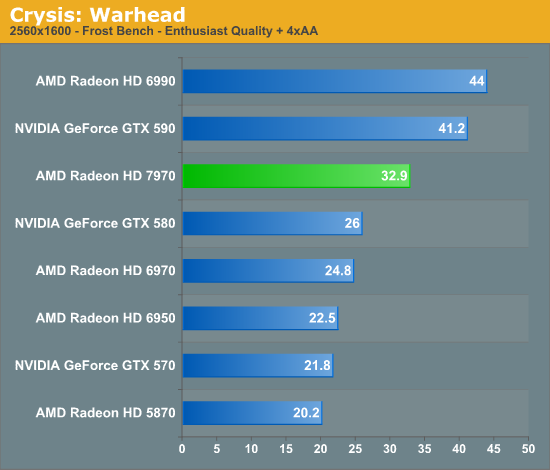

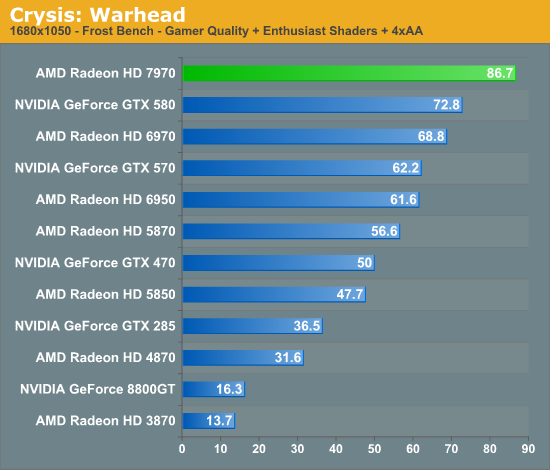
This year we’ve finally cranked our settings up to full Enthusiast quality for 2560 and 1920, so we can finally see where the bar lies. To that extent the 7970 is closer than any single-GPU card before as we’d imagine, but it’s going to take one more jump (~20%) to finally break 60fps at 1920.
Looking at the 7970 relative to other cards, there are a few specific points to look at; the GTX 580 is of course its closest competitor, but we can also see how it does compared to AMD’s previous leader, the 6970, and how far we’ve come compared to DX10 generation cards.
One thing that’s clear from the start is that the tendency for leads to scale with the resolution tested still stands. At 2560 the 7970 enjoys a 26% lead over the GTX 580, but at 1920 that’s only a 20% lead and it shrinks just a bit more to 19% at 1680. Even compared to the 6970 that trend holds, as a 32% lead is reduced to 28% and then 26%. If the 7970 needs high resolutions to really stretch its legs that will be good news for Eyefinity users, but given that most gamers are still on a single monitor it may leave AMD closer to 40nm products in performance than they’d like.
Speaking of 40nm products, both of our dual-GPU entries, the Radeon HD 6990 and GeForce GTX 590 are enjoying lofty leads over the 7970 even with the advantage of its smaller fabrication process. To catch up to those dual-GPU cards from the 6970 would require a 70%+ increase in performance, and even with a full node difference it’s clear that this is not going to happen. Not that it’s completely out of reach for the 7970 once you start looking at overclocking, but the reduction in power usage when moving from TSMC 40nm to 28nm isn’t nearly large enough to make that happen while maintaining the 6970’s power envelope. Dual-GPU owners will continue to enjoy a comfortable lead over even the 7970 for the time being, but with the 7970 being built on a 28nm process the power/temp tradeoff for those cards is even greater compared to 40nm products.
Meanwhile it’s interesting to note just how much progress we’ve made since the DX10 generation though; at 1920 the 7970 is 130% faster than the GTX 285 and 170% faster than the Radeon HD 4870. Existing users who skip a generation are a huge market for AMD and NVIDIA, and with this kind of performance they’re in a good position to finally convince those users to make the jump to DX11.
Finally it should be noted that Crysis is often a good benchmark for predicting overall performance trends, and as you will see it hasn’t let us down here. How well the 7970 performs relative to its competition will depend on the specific game, but 20-25% isn’t too far off from reality.
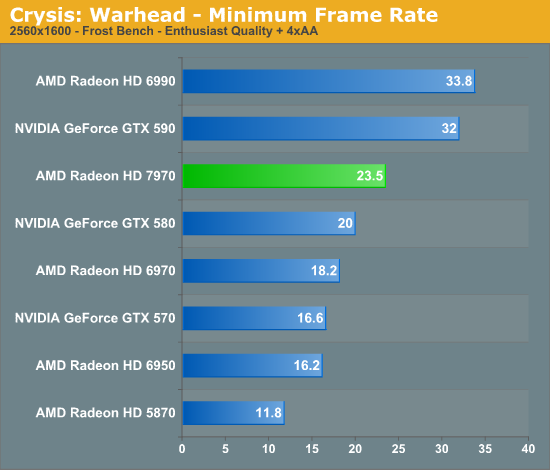
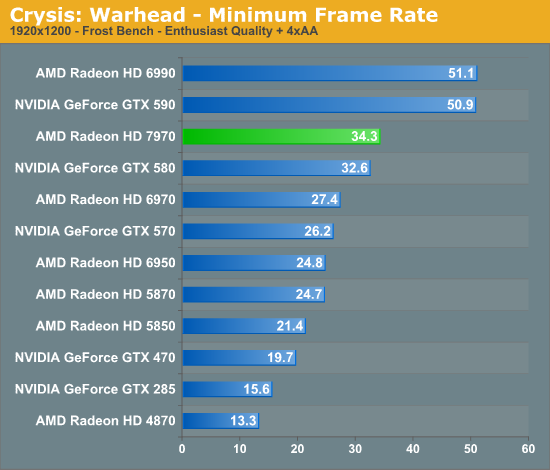
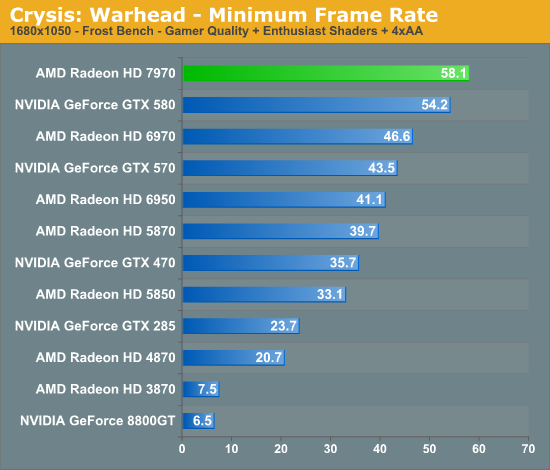
Looking at our minimum framerates it’s a bit surprising to see that while the 7970 has a clear lead when it comes to average framerates the minimums are only significantly better at 2560. At that resolution the lowest framerate for the 7970 is 23.5 versus 20 for the GTX 580, but at 1920 that becomes a 2fps, 5% difference. It’s not that the 7970 was any less smooth in playing Crysis, but in those few critical moments it looks to be dipping a bit more than the GTX 580.
Compared to the 6970 on the other hand the minimum framerate difference is much larger and much more consistent. At 2560 the 7970’s minimums are 29% better, and even at lower resolutions it holds at around 25%. Clearly even with AMD’s new architecture their designs still inherit some of the traits of their old designs.










292 Comments
View All Comments
Zingam - Thursday, December 22, 2011 - link
I think this card is a kinda fail. Well, maybe it is a driver issue and they'll up the performance 20-25% in the future but it is still not fast enough for such huge jump - 2 nodes down!!!It smell like a graphics Bulldozer for AMD. Good ideas on paper but in practice something doesn't work quite right. Raw performance is all that counts (of course raw performance/$).
If NVIDIA does better than usual this time. AMD might be in trouble. Well, will wait and see.
Hopefully they'll be able to release improved CPUs and GPUs soon because this generation does not seem to be very impressive.
I've expected at least triple performance over the previous generation. Maybe the drivers are not that well optimized yet. After all it is a huge architecture change.
I don't really care that much about that GPU generation but I'm worried that they won't be able to put something impressively new in the next generation of consoles. I really hope that we are not stuck with obsolete CPU/GPU combination for the next 7-8 years again.
Anyway: massively parallel computing sounds tasty!
B3an - Thursday, December 22, 2011 - link
You dont seem to understand that all them extra transistors are mostly there for computing. Thats mostly what this was designed for. Not specifically for gaming performance. Computing is where this card will offer massive increases over the previous AMD generation.Look at Nvidia's Fermi, that had way more transistors than the previous generation but wasn't that much faster than AMD's cards at the time. Because again all the extra transistors were mainly for computing.
And come on LOL, expecting over triple the performance?? That has never happened once with any GPU release.
SlyNine - Friday, December 23, 2011 - link
The 9700pro was up to 4x faster then the 4600 in certian situations. So yes it has happened.tzhu07 - Thursday, December 22, 2011 - link
LOL, triple the performance?Do you also have a standard of dating only Victoria's Secret models?
eanazag - Thursday, December 22, 2011 - link
I have a 3870 which I got in early 2007. It still does well for the main games I play: Dawn of War 2 and Starcraft 2 (25 fps has been fine for me here with settings mostly maxed). I have eyeing a new card. I like the power usage and thermals here. I am not spending $500+ though. I am thinking they are using that price to compensate for the mediocre yields they getting on 28nm, but either way the numbers look justified. I will be look for the best card between $150-$250, maybe $300. I am counting on this cards price coming down, but I doubt it will hit under $400-350 next year.No matter what this looks like a successful soft launch of a video card. For me, anything smokes what I have in performance but not so much on power usage. I'd really not mind the extra noise as the heat is better than my 3870.
I'm in the single card strategy camp.
Monitor is a single 42" 1920x1200 60 Hz.
Intel Core i5 760 at stock clocks. My first Intel since the P3 days.
Great article.
Death666Angel - Thursday, December 22, 2011 - link
Can someone explain the different heights in the die-size comparison picture? Does that reflect processing-changes? I'm lost. :D Otherwise, good review. I don't see the HD7970 in Bench, am I blind or is it just missing.Ryan Smith - Thursday, December 22, 2011 - link
The Y axis is the die size. The higher a GPU the bigger it is (relative to the other GPUs from that company).Death666Angel - Friday, December 23, 2011 - link
Thanks! I thought the actual sizes were the sizes and the y-axis meant something else. Makes sense though how you did it! :-)MonkeyPaw - Thursday, December 22, 2011 - link
As a former owner of the 3870, mine had the short-lived GDDR4. That old card has a place in my nerd heart, as it played Bioshock wonderfully.Peichen - Thursday, December 22, 2011 - link
The improvement is simply not as impressive as I was led to believed. Rumor has it that a single 7970 would have the power of a 6990. In fact, if you crunch the numbers, it would be at least 50% faster than 6970 which should put it close to 6990. (63.25% increase in transistors, 40.37% in TFLOP and 50% increase in memory bandwidth.)What we got is a Fermi 1st gen with the price to match. Remember, this is not a half-node improvement in manufacturing process, it is a full-node and we waited two years for this.
In any case, I am just ranting because I am waiting for something to replace my current card before GTA 5 came out. Nvidia's GK104 in Q1 2012 should be interesting. Rumored to be slightly faster than GTX 580 (slower than 7970) but much cheaper. We'll see.